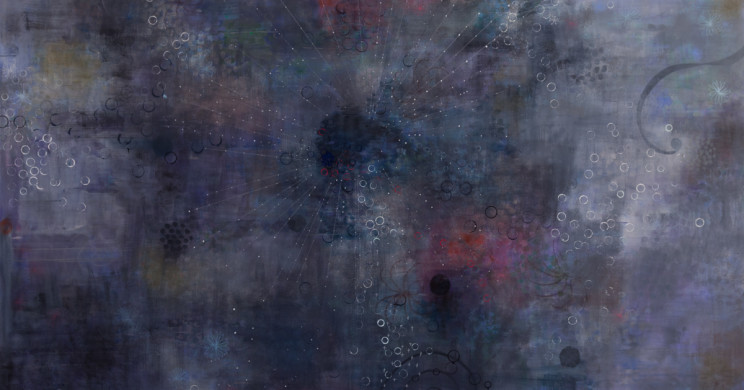While the writer Richard Sennett presumes that contemporary art has been endeavoring to exclude the human hand in art, this notion appears in opposition to the work of artist DARU-Jung Hyang Kim. In examining her work, one may find a very different direction. Kim’s works possess a vibrant delivery of the brush that engages bold sweeping gestures. In the process, she creates a depth of space through a repetition of semi-transparent layers of pigment. Her work presents the artist’s intuitive pleasure through the use of oil paint, pencil, oil stick, and charcoal. Kim’s magical release of energy in her work is an extension of the body – the tactile sensibility – rather than a form of abstract digitalization. Her paintings further reveal not merely an external visual phenomenon but a clearly defined internal manifestation that evolves within the surface. The metamorphosis of nature in her work evokes a hidden feminine desire to live with freedom, dignity, and equality.
DARU-Jung Hyang Kim is a painter and public installation artist who has lived and worked in New York since 1977. She is one of the pioneers of Korean-American art. Kim was accepted into the graduate program of fine arts at Pratt Institute and earned her MFA in 1980. During this period, Kim absorbed many new ideas through her interaction with international artists in New York. Since then, she has maintained a clear direction in her creative experimentation and exploration of new mediums. Her earlier works are diptychs that employ two styles of painting: figuration and abstraction. These opposing elements present different perspectives in her work. In formal terms, her paintings reveal a synthesis between the two. She seeks her own way by creating unique forms that are fundamentally connected to the fluidity of nature and humanist concerns.
In 2013, Kim presented ten paintings in her solo show at Gallery Ho in West Chelsea. These recent works of Kim echo the basic theme on which she has worked over the past three decades. Abstract forms and figurative imagery are integrated on one canvas. Here Kim continues her exploration of abstract forms and shapes as abstraction becomes more predominant in her work. The largest work in this show, Listening Figure-moonlight (2013) focuses on circles and curvilinear shapes overlaid on one another or spread across the surface of the canvas. The circle as an abstract form transmits nuances and offers a rhythmical cadence. Circles are full of spatial volume like the variations in Baroque music. Another work, Listening-swirl (2013), also vibrates with images of circles, which are portrayed as diverse, repeated, and geometric shapes. Their richly varied colors and plastic balance maintains a strong aesthetic value.
In Kim’s work, the circle is the primary element in her visual vocabulary and is laden with symbolic context. Her paintings ultimately belong to the tradition of Korean culture. Kim believes that the variation of circles in her work evokes the qi and invokes the cycle of nature in life, death, and self-renewal. As a critical observer, the philosophical context of her circles is further related to the Eastern (Taoist) concept of Yin and Yang, which is symbolic of positive and negative energy in the universe. Therefore Kim’s circles are not absolutely separated, but are always floating. Kim’s subject matter can be interpreted as a reconciliation of balance, a harmony between opposites, the Eastern world and Western world, including physical limitations and spiritual abundance. Kim’s work is borrowed from her Korean heritage and recontextualized on foreign soil. Her carefully articulated aesthetic discipline brings Eastern depth and Western classicism into a gradually new focus.
























